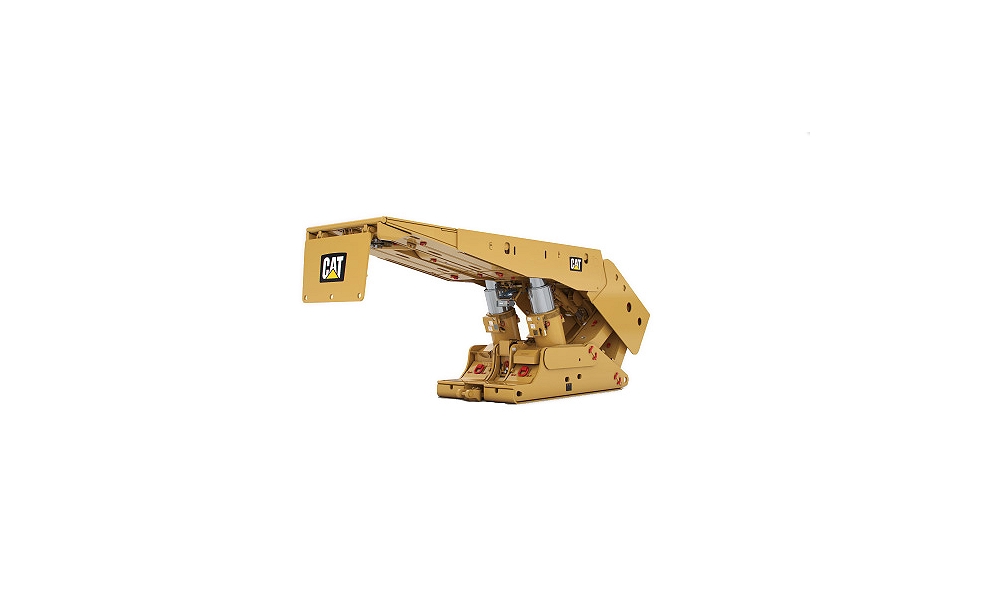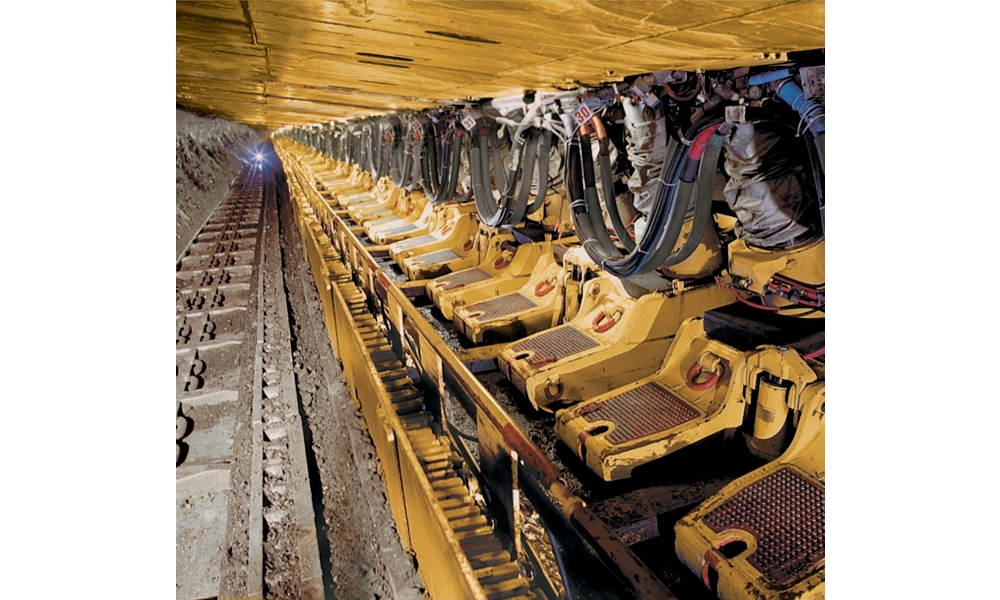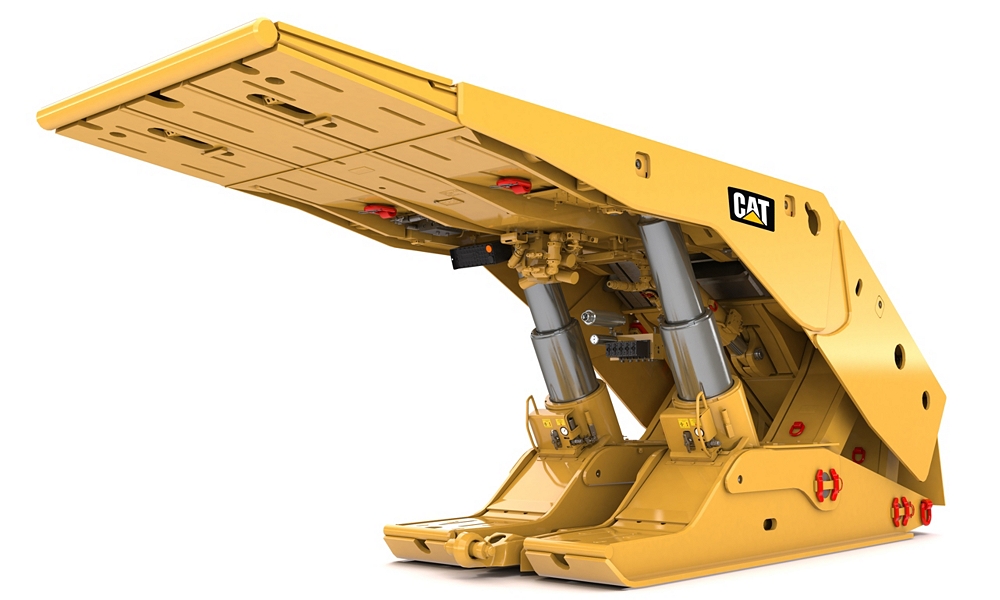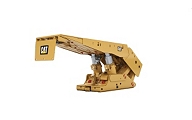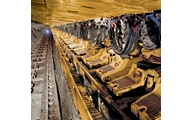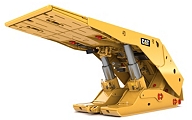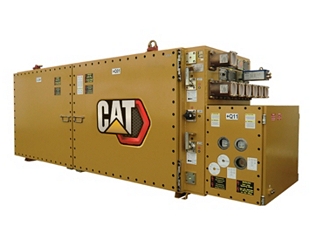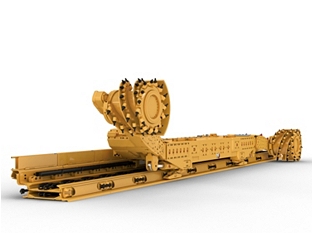Steep grades, very thick and very thin seams, unstable roofs and massive sandstone plates, soft ground and geological faults. These varying conditions require a high level of adaptation to specific requirements. Cat roof supports are world-renowned for their reliability under the most extreme conditions. With superior availability and unparalleled quality in design and production, our roof supports set the standard in longwall mining.
| Range of Roof Supports | |
| Height - Extended | 1100-6100 mm (43.3-240.2 in) |
| Shield Centers | 1500-2050 mm (59-80.7 in) |
| Shield Density | up to 111 tonne/m2 (12.5 ton/ft2) |
Customized Design
State-of-the-art Technology
Caterpillar is the world leader in longwall roof support technology. In the early 1970s, demanding mining conditions in German coal mines set the stage for extensive R&D in roof support technology. Steeply inclined coal seams both thick and thin, weak roofs and massive sandstone roofs, soft floors, and geological faults called for a high degree of customization. The resulting expertise has been deployed and applied to all mining areas of the world and provides customers with state-of-the-art technology customized to maximize control of the roof and floor of their longwalls. This not only eliminates downtime resulting from control of the strata surrounding the coal seam; but also facilitates automation of roof support systems, even in very difficult geological conditions.
Seamless Range
A full range of roof supports are available for mining heights from 550 to 7500 mm (1.80 to 24.60 ft), with support capacities in excess of 1750 tonnes (1,929 tons). As with all Cat products, top quality and leading innovation result in products that deliver maximum performance and system availability, long service life, and lowest possible cost of ownership.
Two-meter Roof Supports
The two meter (6.56 ft) wide roof support offers several advantages over conventional 1.50 or 1.75 meter (4.92 or 5.74 ft) wide shields. Fewer shields mean lower investment and less maintenance - and fewer parts to malfunction. Longwalls are easier to steer and relocation is done faster as there are fewer shields to move.
Control Systems
Caterpillar manufactures a complete range of shield support control systems ranging from manual hydraulic controls to the highly acclaimed PMC-R electronic control system for the most advanced face automation and equipment monitoring. The Cat PMC-R electro-hydraulic longwall face control system represents the cutting edge in longwall automation technology and facilitates full automation, monitoring and remote diagnostics for all face equipment. All information can be transferred to the surface in real time to allow maximization of longwall performance.
Control System Benefits:
- Control flexibility
- User friendliness
- Ease of maintenance
- Reliability and safety
Legs and Cylinders
Legs and cylinders are designed and manufactured to the highest quality and performance standards. Double- and triple-stage systems are available with equal yield rating in all stages. Materials and designs are selected to ensure long service life. Plating is applied to meet the most corrosive environments.
Special Applications
Caterpillar has extensive experience in the design of shield supports for specific mining conditions and for soft-rock longwall applications other than coal. Steepseam supports and supports with articulated forepole extension canopies and high tip loads have been developed for extreme geological situations.
Steep-seam Mining
Faced with the enormous reserves of high quality coal blocked underground and the intensive look of many customers for promising solutions, we have developed and introduced various specific, state-of-the-art systems to also mine steeply inclined coal seams. Caterpillar can offer tailor-made solutions for nearly all conditions, including particularly steep applications.
Conventional Sublevel Caving
Conventional sublevel caving supports allow coal to be drawn from the roof using articulated canopies with special chutes integrated into the gob shield, the front AFC or a second AFC located behind the shields. A large number of shield installations have been supplied to customers, particularly in central and eastern Europe.
Longwall Top Coal Caving
The Longwall Top Coal Caving (LTCC) roof support allows mining to a total seam height of more than 10 m (33 ft) by using a longwall shearer to cut the bottom 2.8-3.0 m (9.2-9.8 ft) and then caving the top coal behind the roof supports onto a rear AFC. This type of longwall is in service for example at a mine in the Hunter Valley, Australia.
Quality
Engineering Excellence
Caterpillar maintains extensive facilities for the design, testing and manufacture of its products. All engineering departments have powerful workstations with state-of-the-art engineering software to enable simultaneous stress analysis and cost effectiveness of design. Finite Element Analysis is used to meet fatigue life requirements of components and products. Design Failure Mode and Effects Analysis is used to maximize reliability of all critical areas to eliminate the risk of in-service failure. Prior experience is used as a feedback process to capture relevant information from many different longwall operations to continuously upgrade product performance for the benefit of our customers. This is invaluable for longwall projects where difficult geological conditions prevail. Cycle testing is a vital part of the design process. Our manufacturing facilities are continually upgraded to take advantage of developing technologies and techniques to achieve maximum quality at minimum cost. In-house technology processes and organizational skills are constantly improved to stay competitive and maximize reliability and performance of high-production automated longwall systems.
Extensive Testing
Before our shields are shipped to the customer, Caterpillar carries out an extensive series of tests on all structural, hydraulic and control components in our own test center. Sophisticated tests check the fatigue strength and load bearing capacity of individual products. Caterpillar has all test systems required for roof supports and their components:
- Three shield test rigs with a force resistance of up to 20 000 kN (4,496,179 lbf) and a test height of more than 5.0 m (197 in)
- Leg and cylinder test machines up to 15 000 kN (3,372,134 lbf)
- Hydraulic test rigs with pressures of up to 1000 bar (14,504 psi) and a volumetric flow rate of more than 500 L/min (132.09 gal/min)
Test Process
The main tests involve longitudinal and lateral bending load and torsion loads in addition to compressive and tensile load. Tests are usually performed with up to 70,000 load cycles with 10% to 20% overload. Complete roof supports are tested as well as individual components such as base, canopy, legs, cylinders, controls, pressure relief valves and hoses. Test measurements confirm calculations and allow constant product improvement and full exploitation of optimization and savings potential. Testing ensures that equipment is suitable for the intended use and will have a guaranteed service life as specified even under extreme conditions.
Safety
Safety First
Caterpillar is proactive in developing roof support systems which meet safety standards around the world:
- Advanced design of critical parts prevents major failures
- Designed for the requirements of the customer and the individual geological condition
- Extensive tests on all structural, hydraulic and control components
- Designed for easy maintenance
- FEA Analysis
- Ergonomic design for human needs Caterpillar has developed a variety of features over time to suit continued improvement on operating safety:
- Diffusion sleeving
- Hose Labeling
- Staple Retention
- Enhanced Staple Design (D-shape)
- D-Shape Super-Stecko
Clear Hose Arrangement
- Clear view
- Superior access to hydraulic components
- Highest safety due to less bending of hoses
- Reliable operation of the equipment
Protective Sleeving
- Atomizes
- Each single hose is uniquely identified and can be tracked back to manufacturing
Stapleless Roof Support Hydraulics
- Less tearing of hoses due to same outside diameter and less damage at staples due to rubbing of staples
- Pressurized connections can't be opened
